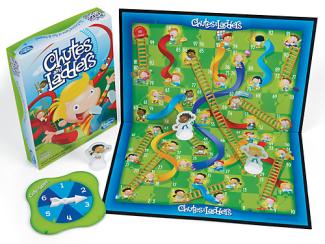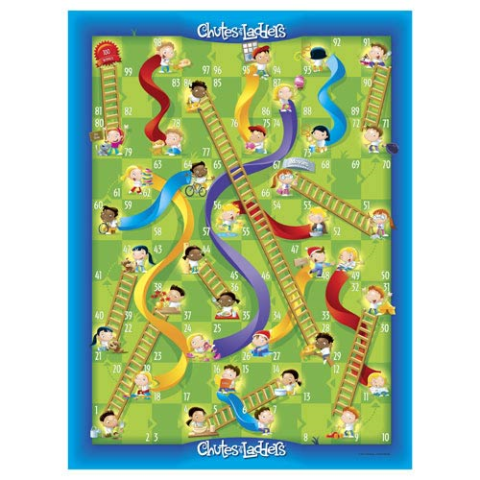
Avoiding Big Chute Risk
Ask anyone (Family Feud style) to name a board game about money--most will say Monopoly.
However, I think the better answer is Chutes and Ladders (or Snakes and Ladders for the international crowd). A simple game of luck for ages 3+ where the player spins a spinner to advance through 100 spaces. If a player lands on a space at the bottom of a ladder, they climb up the ladder, and advance several spaces. If the player lands at the top of a chute, they must slide back, losing progress. First player to reach the top space (100) wins!
If you research the origins of the game, there is a surprisingly large amount of ancient history surrounding this little game. Dating back to the second century BC, it was first used as a tool to teach children the Hindu concept of destiny or fate—where fewer ladders than snakes acted as a reminder that a path of good is more difficult than the path of sins towards the goal of ultimate salvation. Today, the game is still being used to teach lessons on climate change, preventing disease, and now retirement investing.
Stay with me. I promise this will make sense by the end. Let's start by taking a look at the standard Milton Bradley Chutes and Ladders board:
As you can see, there are 100 numbered spaces. There are nine ladders with an average gain of 23.33 spaces. There are 10 chutes, with an average loss of 24.3 spaces. The spinner randomly moves you 1 to 6 spaces per spin.
Now, imagine reaching space 100 is the equivalent of accomplishing 100% of your retirement savings goal. How long (number of spins) will it take you to accomplish your goal?
Glad you asked. To estimate this, I played 30 games, which we will assume is a random sample of all possible games. On average, it took me 37.53 (median = 32) spins to hit the goal. The shortest game took me 10 spins, where I luckily landed on three ladders and zero chutes. The longest game (and major outlier) took 142 spins, where I hit nine ladders and a soul-crushing 15 chutes.
Investing is much the same process. Most of the time, not much is happening. You contribute savings bit by bit, and your portfolio generally moves in a positive direction. Then, occasionally you earn some big investment returns (a ladder). In my little study, I landed on a ladder space only 10.7% of my spins, but those spins accounted for a relatively large proportion of total progress towards my goal. In real life, if you somehow managed to miss the best 25 days of market returns from 1970 to 2016, your returns would have gone from 1,910% to 371%, or 6.7% a year to 3.4%. The study itself is a bit silly, as it would be statistically and operationally impossible to actually miss the 25 biggest days and catch all the rest, but the illustrative point is--we need the ladders, because ladders contribute a large part of total return attribution.
On the other side, we can’t have return (ladders) without accepting risk (chutes). If you consider savings contributions over time as spins, and market appreciation as ladders, market downturns are the chutes of the investment world, and they’re unavoidable. You don't sit down with the fam for a friendly game of Chutes and Ladders and not expect to land on a chute or two; and, although it might seem like it at the time (especially if you're playing with a three-year-old), it's not the end of the world, and you can recover and go on towards your goal.
It’s "the big chute" on dreaded space 87 that you pray you don’t land on. If you land on space 87, you immediately lose 63 spaces (a 72.41% loss). It feels so devastating because it occurs so late in your game play (87% to the goal). In 30 games, I landed on the big chute a total of 23 times, and it was terrible every. single. time. Landing on space 87 significantly increases time and the number of spins it will ultimately take to complete the goal. In my games where I did not land on space 87, my average number of spins was 27.3, as compared to an average of 58 spins in games where I travelled down the big chute at least once.
In truth, while space 87 is the largest “per space” loss, it is not the largest % loss. That designation belongs to space 49, where a player slides all the way back to space 11 for a 77.55% loss of forward progress. However, behaviorally, space 49 doesn’t seem quite so devastating as compared to space 87. You’ve still got a long way to go, and many opportunities for recovery, much like savers young in their savings career.
Past space 64, there are no chutes that catapult you back down below space 73 (besides space 87), there are only small chutes (appropriate risks), which at most result in a loss of 20 spaces. So even in this simple game of luck and probability, a player's risk is minimized after they progress about 2/3 to the goal, at space 65. If you were to somehow able to eliminate "big chute risk," as you can in real life, the worst that can happen is you end up back at space 73 (a player's floor for loss).
Wait. Did you just say I can avoid "big chute risk" in real life?! Yes, my friends, by reducing your investment risk (less stocks, more bonds) as you edge closer to your retirement goal, you can eliminate “big chute risk" without sacrificing your opportunity for big ladders while you’re young. As you near the top, investors still have the little chutes to contend with, but successful long-term investing looks exactly like the Chutes and Ladders board, sans that ugly purple thing down the middle.
Some of this may seem silly and simplistic, but investing does not have to be hard. This is a game a three-year-old can play. As long as you diligently keep spinning, and avoid big chute risks, you will reach your goals. Let Radix Financial help.
Happy Thanksgiving!
Amy Hubble, PhD, CFA, CFP®


